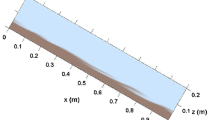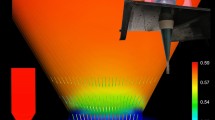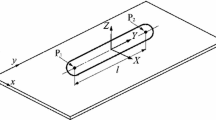Abstract
Granular flow exists widely in nature or industrial production, and particle shape is a crucial factor affecting the flow characteristics of granular materials. In this study, spherical and cylindrical particles are constructed by superquadric equations, and the discharging processes of granular materials in the conical silo are simulated by the discrete element method. Subsequently, the effects of blockiness, aspect ratio and hopper angle on the flow characteristics are investigated. The results show that the discharge rates of cylindrical particles increase and flow fluctuation decreases as the blockiness parameters and aspect ratios decrease or the hopper angles increase. Compared with spherical particles, cylindrical particles are more likely to cause interlocking and hinder sliding or rotation between particles, which results in intermittent granular flow. Furthermore, the flow pattern transition is dominated by the particle shape and hopper angle. The critical height between the mass and funnel flows decreases as the blockiness parameter decreases or the aspect ratio and hopper angle increase and reaches a steady state. However, the effect of particle shape on the flow pattern transition becomes negligible for a larger hopper angle. When the hopper angle is larger than 60°, the granular system basically has a uniform vertical velocity and all particles are in the mass flow. On the microscopic scale, cylindrical particles have a larger average coordination number and greater possibility of strong contact force than spherical particles, which may further cause the flow pattern transition of granular materials on the macroscopic scale.
Graphical Abstract




















Similar content being viewed by others
References
Cundall, P.A., Strack, O.D.L.: A Discrete numerical mode for granular assemblies. Géotechnique 29(1), 47–65 (1979). https://doi.org/10.1680/geot.1979.29.1.47
Zhao, B., An, X., Zhao, H., Shen, L., Sun, X., Zhou, Z.: DEM simulation of the local ordering of tetrahedral granular matter. Soft Matter 15(10), 2260–2268 (2019). https://doi.org/10.1039/c8sm02166j
Kodicherla, S.P.K., Gong, G., Yang, Z.X., Krabbenhoft, K., Fan, L., Moy, C.K.S., Wilkinson, S.: The influence of particle elongations on direct shear behaviour of granular materials using DEM. Granul. Matter 21, 86 (2019). https://doi.org/10.1007/s10035-019-0947-x
Li, Y., Ji, S.: A geometric algorithm based on the advancing front approach for sequential sphere packing. Granul. Matter 20, 59 (2018). https://doi.org/10.1007/s10035-018-0829-7
Zhao, Y., Yang, S., Zhang, L., Chew, J.W.: Understanding the varying discharge rates of lognormal particle size distributions from a hopper using the Discrete Element Method. Powder Technol. 342, 356–370 (2019). https://doi.org/10.1016/j.powtec.2018.09.080
Yan, Y., Ji, S.: Energy conservation in a granular shear flow and its quasi-solid–liquid transition. Part. Sci. Technol. 27(2), 126–138 (2009). https://doi.org/10.1080/02726350902775970
Vijayan, A., Annabattula, R.K.: Effect of particle flow dynamics on the fabric evolution in spherical granular assemblies filled under gravity. Powder Technol. 356, 909–919 (2019). https://doi.org/10.1016/j.powtec.2019.09.027
Gallego, E., Fuentes, J.M., Wiącek, J., Villar, J.R., Ayuga, F.: DEM analysis of the flow and friction of spherical particles in steel silos with corrugated walls. Powder Technol. 355, 425–437 (2019). https://doi.org/10.1016/j.powtec.2019.07.072
Xie, C., Ma, H., Zhao, Y.: Investigation of modeling non-spherical particles by using spherical discrete element model with rolling friction. Eng. Anal. Bound. Elem. 105, 207–220 (2019). https://doi.org/10.1016/j.enganabound.2019.04.013
Zhao, S., Evans, T.M., Zhou, X.: Shear-induced anisotropy of granular materials with rolling resistance and particle shape effects. Int. J. Solids Struct. 150, 268–281 (2018). https://doi.org/10.1016/j.ijsolstr.2018.06.024
Lu, G., Third, J.R., Müller, C.R.: Discrete element models for non-spherical particle systems: from theoretical developments to applications. Chem. Eng. Sci. 127, 425–465 (2015). https://doi.org/10.1016/j.ces.2014.11.050
Kafashan, J., Wiącek, J., Abd Rahman, N., Gan, J.: Two-dimensional particle shapes modelling for DEM simulations in engineering: a review. Granul. Matter. 21, 80 (2019). https://doi.org/10.1007/s10035-019-0935-1
Li, C., Peng, Y., Zhang, P., Zhao, C.: The contact detection for heart-shaped particles. Powder Technol. 346, 85–96 (2019). https://doi.org/10.1016/j.powtec.2019.01.079
Zhao, S., Zhao, J.: A poly-superellipsoid‐based approach on particle morphology for DEM modeling of granular media. Int. J. Numer. Anal. Methods Geomech. 43(13), 2147–2169 (2019). https://doi.org/10.1002/nag.2951
Li, L., Marteau, E., Andrade, J.E.: Capturing the inter-particle force distribution in granular material using LS-DEM. Granul. Matter 21, 43 (2019). https://doi.org/10.1007/s10035-019-0893-7
Khazeni, A., Mansourpour, Z.: Influence of non-spherical shape approximation on DEM simulation accuracy by multi-sphere method. Powder Technol. 332, 265–278 (2018). https://doi.org/10.1016/j.powtec.2018. 03.030
Li, C.X., Zhou, Z.Y., Zou, R.P., Pinson, D., Shen, Y.S., Yu, A.B.: Experimental and numerical investigation on the packing of binary mixtures of spheres and ellipsoids. Powder Technol. 360, 1210–1219 (2020). https://doi.org/10.1016/j.powtec.2019.10.103
Feng, Y.T., Han, K., Owen, D.R.J.: A generic contact detection framework for cylindrical particles in discrete element modelling. Comput. Methods Appl. Mech. Eng. 315, 632–651 (2017). https://doi.org/10.1016/j.cma.2016.11.001
Feng, Y.T., Owen, D.R.J.: A 2D polygon/polygon contact model: algorithmic aspects. Eng. Comput. 21(2/3/4), 265–277 (2004). https://doi.org/10.1108/02644400410519785
Feng, Y.T., Han, K., Owen, D.R.J.: Energy-conserving contact interaction models for arbitrarily shaped discrete elements. Comput. Methods Appl. Mech. Eng. 205–208, 169–177 (2012). https://doi.org/10.1016/j.cma.2011.02.010
Feng, Y.T., Tan, Y.: On Minkowski difference-based contact detection in discrete/discontinuous modelling of convex polygons/polyhedra. Eng. Comput. 37(1), 54–72 (2019). https://doi.org/10.1108/ec-03-2019-0124
Liu, L., Ji, S.: Bond and fracture model in dilated polyhedral DEM and its application to simulate breakage of brittle materials. Granul. Matter 21, 41 (2019). https://doi.org/10.1007/s10035-019-0896-4
Han, K., Feng, Y.T., Owen, D.R.J.: Polygon-based contact resolution for superquadrics. Int. J. Numer. Methods Eng. 66, 485–501 (2006). https://doi.org/10.1002/nme.1569
Lu, G., Third, J.R., Müller, C.R.: Critical assessment of two approaches for evaluating contacts between super-quadric shaped particles in DEM simulations. Chem. Eng. Sci. 78(34), 226–235 (2012). https://doi.org/10.1016/j.ces.2012.05.041
Nie, J.-Y., Li, D.-Q., Cao, Z.-J., Zhou, B., Zhang, A.-J.: Probabilistic characterization and simulation of realistic particle shape based on sphere harmonic representation and Nataf transformation. Powder Technol. 360, 209–220 (2020). https://doi.org/10.1016/j.powtec.2019.10.007
Mollon, G., Zhao, J.: 3D generation of realistic granular samples based on random fields theory and Fourier shape descriptors. Comput. Methods Appl. Mech. Eng. 279, 46–65 (2014). https://doi.org/10.1016/j.cma.2014.06.022
Cleary, P.W.: Effect of rock shape representation in DEM on flow and energy utilisation in a pilot SAG mill. Comput. Particle Mech. 6(3), 461–477 (2019). https://doi.org/10.1007/s40571-019-00226-3
Williams, J.R., Pentland, A.P.: Superquadrics and modal dynamics for discrete elements in interactive design. Eng. Comput. 9(2), 115–127 (1992). https://doi.org/10.1108/eb023852
Zhong, W., Yu, A., Liu, X., Tong, Z., Zhang, H.: DEM/CFD-DEM modelling of non-spherical particulate systems: theoretical developments and applications. Powder Technol. 302, 108–152 (2016). https://doi.org/10.1016/j.powtec.2016.07.010
Tangri, H., Guo, Y., Curtis, J.S.: Hopper discharge of elongated particles of varying aspect ratio: Experiments and DEM simulations. Chem. Eng. Sci. X. 4, 100040 (2019). https://doi.org/10.1016/j.cesx.2019.100040
Höhner, D., Wirtz, S., Scherer, V.: A study on the influence of particle shape on the mechanical interactions of granular media in a hopper using the discrete element method. Powder Technol. 278, 286–305 (2015). https://doi.org/10.1016/j.powtec.2015.02.046
You, Y., Zhao, Y.: Discrete element modelling of ellipsoidal particles using super-ellipsoids and multi-spheres: a comparative study. Powder Technol. 331, 179–191 (2018). https://doi.org/10.1016/j.powtec.2018. 03.017
Liu, S.D., Zhou, Z.Y., Zou, R.P., Pinson, D., Yu, A.B.: Flow characteristics and discharge rate of ellipsoidal particles in a flat bottom hopper. Powder Technol. 253, 70–79 (2014). https://doi.org/10.1016/j.powtec.2013.11.001
Höhner, D., Wirtz, S., Scherer, V.: Experimental and numerical investigation on the influence of particle shape and shape approximation on hopper discharge using the discrete element method. Powder Technol. 235, 614–627 (2013). https://doi.org/10.1016/j.powtec.2012.11.004
Gui, N., Yang, X., Tu, J., Jiang, S.: Numerical study of the motion behaviour of three-dimensional cubic particle in a thin drum. Adv. Powder Technol. 29(2), 426–437 (2018). https://doi.org/10.1016/j.apt.2017.11.033
Cleary, P.W., Sawley, M.L.: DEM modelling of industrial granular flows: 3D case studies and the effect of particle shape on hopper discharge. Appl. Math. Model. 26(2), 89–111 (2002)
Wang, S., Fan, Y., Ji, S.: Interaction between super-quadric particles and triangular elements and its application to hopper discharge. Powder Technol. 339, 534–549 (2018). https://doi.org/10.1016/j.powtec.2018.08.026
AH, B.: Superquadrics and angle-preserving transformations. IEEE Comput. Graphics Appl. 1(1), 11–23 (1981). https://doi.org/10.1109/MCG.1981.1673799
Peng, D., Hanley, K.J.: Contact detection between convex polyhedra and superquadrics in discrete element codes. Powder Technol. 356, 11–20 (2019). https://doi.org/10.1016/j.powtec.2019.07.082
Kildashti, K., Dong, K., Samali, B.: An accurate geometric contact force model for super-quadric particles. Comput. Methods Appl. Mech. Eng. (2020). https://doi.org/10.1016/j.cma.2019.112774
Gan, J., ·Yu, A.B.: DEM simulation of the packing of cylindrical particles. Granul. Matter 22, 22 (2020). https://doi.org/10.1007/s10035-019-0993-4
Ma, H., Zhao, Y.: Investigating the flow of rod-like particles in a horizontal rotating drum using DEM simulation. Granul. Matter. 20, 41 (2018). https://doi.org/10.1007/s10035-018-0823-0
Fritzer, H.P.: Molecular symmetry with quaternions. Spectrochim. Acta Part A. 57, 1919–1930 (2001). https://doi.org/10.1016/S1386-1425(01)00477-2
Kosenko, I.I.: Integration of the equations of a rotational motion of a rigid body in quaternion algebra. The Euler case. J. Appl. Math. Mech. 62, 193–200 (1998). https://doi.org/10.1016/S0021-8928(98)00025-2
Miller, I.I.I.T.F., Eleftheriou, M., Pattnaik, P., Ndirango, A., Newns, D., Martynaa, G.J.: Symplectic quaternion scheme for biophysical molecular dynam. J. Chem. Phys. 116, 8649–8659 (2002). https://doi.org/10.1063/1.1473654
Zhu, H.P., Zhou, Z.Y., Yang, R.Y., Yu, A.B.: Discrete particle simulation of particulate systems: theoretical developments. Chem. Eng. Sci. 62(13), 3378–3396 (2007). https://doi.org/10.1016/j.ces.2006.12.089
Zhu, H.P., Zhou, Z.Y., Yang, R.Y., Yu, A.B.: Discrete particle simulation of particulate systems: a review of major applications and findings. Chem. Eng. Sci. 63(23), 5728–5770 (2008). https://doi.org/10.1016/j.ces.2008.08.006
Wellmann, C., Lillie, C., Wriggers, P.: A contact detection algorithm for superellipsoids based on the common-normal concept. Eng. Comput. 25(5), 432–442 (2008). https://doi.org/10.1108/02644400810881374
Houlsby, G.T.: Potential particles: a method for modelling non-circular particles in DEM. Comput. Geotech. 36(6), 953–959 (2009). https://doi.org/10.1016/j.compgeo.2009.03.001
Podlozhnyuk, A., Pirker, S., Kloss, C.: Efficient implementation of superquadric particles in discrete element method within an open-source framework. Comput. Particle Mech. 4(1), 101–118 (2016). https://doi.org/10.1007/s40571-016-0131-6
Soltanbeigi, B., Podlozhnyuk, A., Papanicolopulos, S.-A., Kloss, C., Pirker, S., Ooi, J.Y.: DEM study of mechanical characteristics of multi-spherical and superquadric particles at micro and macro scales. Powder Technol. 329, 288–303 (2018). https://doi.org/10.1016/j.powtec.2018.01.082
Kodam, M., Bharadwaj, R., Curtis, J., Hancock, B., Wassgren, C.: Cylindrical object contact detection for use in discrete element method simulations, part II—experimental validation. Chem. Eng. Sci. 65, 5863–5871 (2010). https://doi.org/10.1016/j.ces.2010.08.007
Ge, L., Gui, N., Yang, X., Tu, J., Jiang, S.: Effects of aspect ratio and component ratio on binary-mixed discharging pebble flow in hoppers. Powder Technol. 355, 320–332 (2019). https://doi.org/10.1016/j.powtec.2019. 07.045
Govender, N., Wilke, D.N., Pizette, P., Abriak, N.-E.: A study of shape non-uniformity and poly-dispersity in hopper discharge of spherical and polyhedral particle systems using the Blaze-DEM GPU code. Appl. Math. Comput. 319, 318–336 (2018). https://doi.org/10.1016/j.amc.2017.03.037
Langston, P.A., Al-Awamleh, M.A., Fraige, F.Y., Asmar, B.N.: Distinct element modelling of non-spherical frictionless particle flow. Chem. Eng. Sci. 59(2), 425–435 (2004). https://doi.org/10.1016/j.ces.2003. 10.008
Hidalgo, R.C., Zuriguel, I., Maza, D., Pagonabarraga, I.: Granular packings of elongated faceted particles deposited under gravity. J. Stat. Mech. Theory Exp. 2010(06), P06025 (2010). https://doi.org/10.1088/1742-5468/2010/06/p06025
Zhang, Y., Jia, F., Zeng, Y., Han, Y., Xiao, Y.: DEM study in the critical height of flow mechanism transition in a conical silo. Powder Technol. 331, 98–106 (2018). https://doi.org/10.1016/j.powtec.2018.03.024
Acknowledgements
This study is financially supported by the National Key Research and Development Program of China (Grant Nos. 2018YFA0605902, 2016YFC1401505 and 2016YFC1402706), the National Natural Science Foundation of China (Grant Nos. 11872136 and 11772085) and the Fundamental Research Funds for the Central Universities (Grant Nos. DUT19GJ206 and DUT19ZD207).
Author information
Authors and Affiliations
Corresponding author
Ethics declarations
Conflict of interest
The authors declare that there is no conflict of interest regarding the publication of this paper.
Additional information
Publisher's Note
Springer Nature remains neutral with regard to jurisdictional claims in published maps and institutional affiliations.
This article is part of the Topical Collection: Flow regimes and phase transitions in granular matter: multiscale modeling from micromechanics to continuum.
Rights and permissions
About this article
Cite this article
Wang, S., Yan, Y. & Ji, S. Transition of granular flow patterns in a conical hopper based on superquadric DEM simulations. Granular Matter 22, 79 (2020). https://doi.org/10.1007/s10035-020-01051-9
Received:
Published:
DOI: https://doi.org/10.1007/s10035-020-01051-9




